Damage in hybrid corrugated core sandwich structures under high velocity hail ice impact: A numerical study
2023-10-09ChoZhngXinFngJoseCurielSosTinhQuoBuiChunjinMo
Cho Zhng ,Xin Fng ,Jose L.Curiel-Sos ,Tinh Quo Bui ,Chunjin Mo
a School of Mechanical Engineering,Jiangsu University,Zhenjiang,China
b Department of Mechanical Engineering,The University of Sheffield,Sheffield,UK
c Duy Tan Research Institute for Computational Engineering,Duy Tan University,Ho Chi Minh City,Viet Nam
d State Key Laboratory of Mechanics and Control of Mechanical Structures,Nanjing University of Aeronautics and Astronautics,Nanjing,China
Keywords:Sandwich structure Hail ice impact Damage behavior Energy absorption FE-SPH modeling
ABSTRACT Potential damage in composite structures caused by hail ice impact is an essential safety threat to the aircraft in flight.In this study,a nonlinear finite element (FE) model is developed to investigate the dynamic response and damage behavior of hybrid corrugated sandwich structures subjected to high velocity hail ice impact.The impact and breaking behavior of hail are described using the FE-smoothed particle hydrodynamics (FE-SPH) method.A rate-dependent progressive damage model is employed to capture the intra-laminar damage response;cohesive element and surface-based cohesive contact are implemented to predict the inter-laminar delamination and sheet/core debonding phenomena respectively.The transient processes of sandwich structure under different hail ice impact conditions are analyzed.Comparative analysis is conducted to address the influences of core shape and impact position on the impact performance of sandwich structures and the corresponding energy absorption characteristics are also revealed.
1.Introduction
Composite sandwich structure is a kind of lightweight composite structure composed of sheets,core and adhesive layers.In the past few decades,composite sandwich structures have been increasingly applied in the aerospace,marine and automotive engineering fields due to their much better bending,shear,torsion and energy absorption properties over conventional laminated composites.Composite sandwich structures have different core structures,such as honeycomb core,corrugated core,foam core and lattice truss core.Among them,the corrugated core sandwich structure tends to exhibit superior impact resistance under external loadings due to its good energy absorption capacity with plastic deformation thus has attracted extensive attentions.
Low velocity impact response of corrugated sandwich structures has been an important topic in the past decades.Liu et al.and Rong et al.[1,2] conducted the experimental test and numerical simulation to analyze the effect of impactor shape and core configuration on the low velocity impact response of corrugated sandwich structure.It was found that in non-penetration case,the specimen absorbs the least energy under conical impactor while absorbs the most energy under flat impactor.However,in perforation case,the results are just the opposite.Besides,the trapezoidal sandwich structure has advantages in energy absorption and lateral compression performance.Hou et al.[3] explored the failure mechanism and energy absorption of multi-layer corrugated sandwich panels through experimental investigation and FE modeling.They reported that the multi-layer corrugated sandwich panels have a better energy absorption capacity and higher mechanical properties under quasi-static crushing loading compared with single-layer counterpart.Yang et al.[4] evaluated the impact resistance and damage mechanism of curved corrugated sandwich shells and it was showed that such novel curved structure can withstand greater low velocity impact loading and significantly improve the energy absorption capacity.Some other works for investigating the low velocity impact behavior and damage evolution of corrugated sandwich structures can also be found in Refs.[5-10].
Different from the above rigid impact scenes,the corrugated sandwich structures especially for those exposed application in the wing and rudder of aircraft would inevitably come across soft body impact cases such as hail ice impact.The barely visible intralaminar and inter-laminar damage induced by hail ice impact may significantly reduce the residual mechanical performance of sandwich structures thus become an essential safety threat to the aircraft in flight.Therefore,it is significant to study the hail impact damage behavior of composite sandwich structures for structural design and evaluation.However,the current related works mainly focus on the hail ice impact problems of laminated composites.By the hail impact test,the failure threshold energy(FTE)is studied by Rhymer et al.[11,12]considering different impact conditions.They have found a linear relation with the ratio of plate thickness to ice diameter in the context of the FTE.The delamination initiation caused by hail impact was determined by the inter-laminar fracture strength rather than the fiber arrangement or fiber properties.Pernas-Sanchez et al.[13,14]explored the high velocity hail impact response of composite laminates by non-destructive technique,which can provide exact quantification of delamination area.Liu et al.[15] proposed a damage threshold prediction model of composite laminates based on the dynamic deformation and delamination and a conservative damage threshold could be predicted from this model at low cost.By scanning electron microscopy(SEM),Tang et al.[16] analyzed the delamination morphology of composite laminates under high velocity impact of ice projectile.Moreover,the accuracy of using interfacial cohesive elements to describe the inter-laminar delamination was also validated.
However,thus far,the available studies on the hail ice impact behavior of composite sandwich structures are relatively limited.Dolati et al.[17]developed an FE model to simulate the hail impact process and damage behavior of corrugated sandwich plate and the influence of hail shape,sheet stacking sequence and fiber type on the impact response were studied.Song et al.[18,19] investigated the damage response of honeycomb sandwich panels under diverse hail ice impact velocities and angles.It was found that the denting depth has a linear relation with the impact energy at diverse impact angles and the normal component of impact velocity is the main factor of failure.Besides,Vignjevic et al.[20]studied the soft body impact response of composite corrugated foam sandwich panels and concluded that such structure shows better impact resistance than traditional sandwich plate.
With the growing application of corrugated sandwich structure in the aircraft,it is necessary to further study the hail impact behavior and corresponding failure mechanism to support the high-cost and long-term safety certification requirements.This work aims at developing a nonlinear FE model to explore the dynamic response,damage behavior and energy absorption characteristics of corrugated sandwich structures.The FE-SPH method is applied to model the breaking and flow characteristics of hail ice.The rate-dependent constitutive relations of composite ply and aluminum core are considered.The inter-laminar delamination and sheet/core debonding behavior are simulated by the aid of cohesive element and cohesive contact respectively.The present work offers new insights for understanding the hail ice impact response of sandwich structures and also provides transferable modeling technique for studying the soft body impact problems of other composite structures.
2.Damage constitutive model
2.1.Constitutive model of ice
The ice generally exhibits different behaviors dependent upon the level of strain rate,i.e.,it behaves brittle at high strain rate while ductile at low strain rate.The tensile properties of ice are not affected by the strain rate whereas the compressive yield strength is greatly affected by the strain rate [21].To capture the hail ice mechanical behavior,the rate-dependent elastic-plastic model for ice proposed by Tippmann et al.[22] is employed.Here,we provided in Tables 1 and 2 the information of the rate-dependent yield strengths and mechanical parameters of ice,respectively.When satisfying the tensile failure stress,i.e.,the deviatoric stress is equal to zero,in such a condition the ice can only bear compressive stress.The degraded elements are then converted into SPH particles after damage.The shear and compressive stresses failure are set to be brittle and ductile,respectively.
After failure,the Gruneisen equation of state (EoS) of water is employed to represent the flow characteristics of ice.For the compression state (μ>0),one has [17]
For the expansion state (μ<0),one has [17]
In the above equations,Pis the pressure;CSis the volumetric sound velocity;S1,S2,S3are the first,second and third slope of theUs-Upcurve (UsandUpare the shock wave and particle velocity);E,α andγ0are the initial internal energy,volumetric adjustment coefficient and Gruneisen coefficient,respectively;μ=ρ/ρ0-1,and ρ is the current density and ρ0is the initial density.The Gruneisen EoS parameters of water are summarized and provided in Table 3.

Table 1 Data of rate dependent yield strength of ice [22].

Table 2 Mechanical parameters of ice [22].

Table 3 Parameters of Gruneisen EoS [17].
2.2.Constitutive model of aluminum core
Johnson-Cook model [23] considers the effects of strain,strain rate and temperature on stress simultaneously thus it is generally used in the impact simulation of metal structures.The Johnson-Cook model,which is a visco-plastic model,consists of the constitutive law and failure model.
The effective stress can be described as follows:
where,Ais the initial yield stress;Bis the hardening constant;ε is the effective plastic strain;n is the hardening exponent;C is the strain rate constant;is the normalized effective plastic strain rate;m is the thermal softening exponent;T*is the dimensionless temperature and defined by
whereTris the room temperature andTmis the melting point.
The failure model is defined by the cumulative damage law as
where Δεeqis the increment of effective plastic strain;εfis the plastic fracture strain and expressed by
where σ*denotes the mean stress,which is normalized by the effective stress;D1-D5are the failure parameters determined from the experimental data.
2.3.Rate-dependent constitutive model of composite ply
In this study,the fiber is assumed to be transversely isotropic linear-elastic material while the matrix is to be isotropic viscoelastic material.A spring element is used to model the fiber and a spring in parallel with 2 Mx elements is used to model the matrix.Each ply of laminates is considered as unidirectional composite.
Based on the iso-strain assumption,the longitudinal behavior of unidirectional composite can be described by
where,Ef1is the fiber longitudinal modulus;Vfis the fiber volume fraction;Eris the matrix relaxation modulus.
where,Vm=1-Vf;Emis the matrix elastic modulus;E1,E2are the time-dependent modulus and θe1and θe2are the relaxation time in the Maxwell elements.
Based on the iso-strain or iso-stress assumption,see Ref.[24],the stress-strain constitutive law in the other directions can be given by
WithCbeing the stiffness matrix,the constitutive relation of composite ply is
whereUandEare detailed as follows:
Then,for the transversely isotropic properties,the 3D ratedependent constitutive relation of unidirectional composite can be represented as
During the hail ice impact process,the four typical failure modes of composites are captured by using 3D Hashin failure criteria[25].When failure occurring,the composite generally loses its bearing capacity in certain mode,and the related material properties need to be degraded.In this work,a sudden elastic stiffness reduction rule,shown in Table 4,is employed.

Table 5 Material parameters of unidirectional composite [24,28].

Table 6 Material parameters of cohesive interfacial elements.
2.4.Constitutive model of interface
For the hail ice impact simulation of corrugated sandwich structure,the inter-laminar delamination and sheet/core debonding behavior should be considered.In this paper,the zero-thickness cohesive elements are introduced to describe the inter-laminar delamination phenomenon in the composite sheet;the surface- based cohesive contact is employed to identify the debonding phenomenon between the sheets and core.
The initial elastic relation of interface is expressed as
whereKis the interfacial stiffness,tiand δiare the stresses and corresponding separation displacements,respectively.
To consider the combination of normal and shear separations,the current relative displacement in mixed mode,δm,is defined as
where,〈δ1〉=max{0,δ1} and δshearrepresents the tangential relative displacement of the interface.
The initial damage displacement of interface,δ0m,is determined by Ref.[26].
withN,SandTrepresenting the tensile and two shear strengths of interface,respectively.
where,GI,GIIandGIIIare the interface current energy release rates of mode I,II and III;GIC,GIICandGIIICare the critical fracture energies.
After damage initiation,the damage variabledis driven through a linear damage evolution as follows:
3.Nonlinear finite element model
3.1.Verification of the developed damage models
To show the applicability of the proposed damage constitutive models,the experimental results reported in Ref.[27] are adopted for our comparison purpose.The boundary conditions are sketched in Fig.1.To achieve a stable state,the specimen is then fastened to the bottom plate by pressure plate and bolts,and the composite laminates are fully fixed on all sides.The specimen size is 250 × 250 mm2.The window size is 200 × 200 mm2and the pressure plate and bottom plate sizes are 300 × 300 mm2.The stacking sequence of the laminates is orthogonal layup [0°/90°]4Sand quasi-isotropic layup[0°/45°/90°/-45°]2S.The thickness of each ply is 0.125 mm.The diameter of hail is 25.4 mm and the hail is meshed by C3D8R elements.When reaching the failure stress,the failed hail element automatically converts into SPH particles.Each ply of the composite laminates is also discretized with C3D8R element,and a local coordinate system is established to define the local fiber direction.
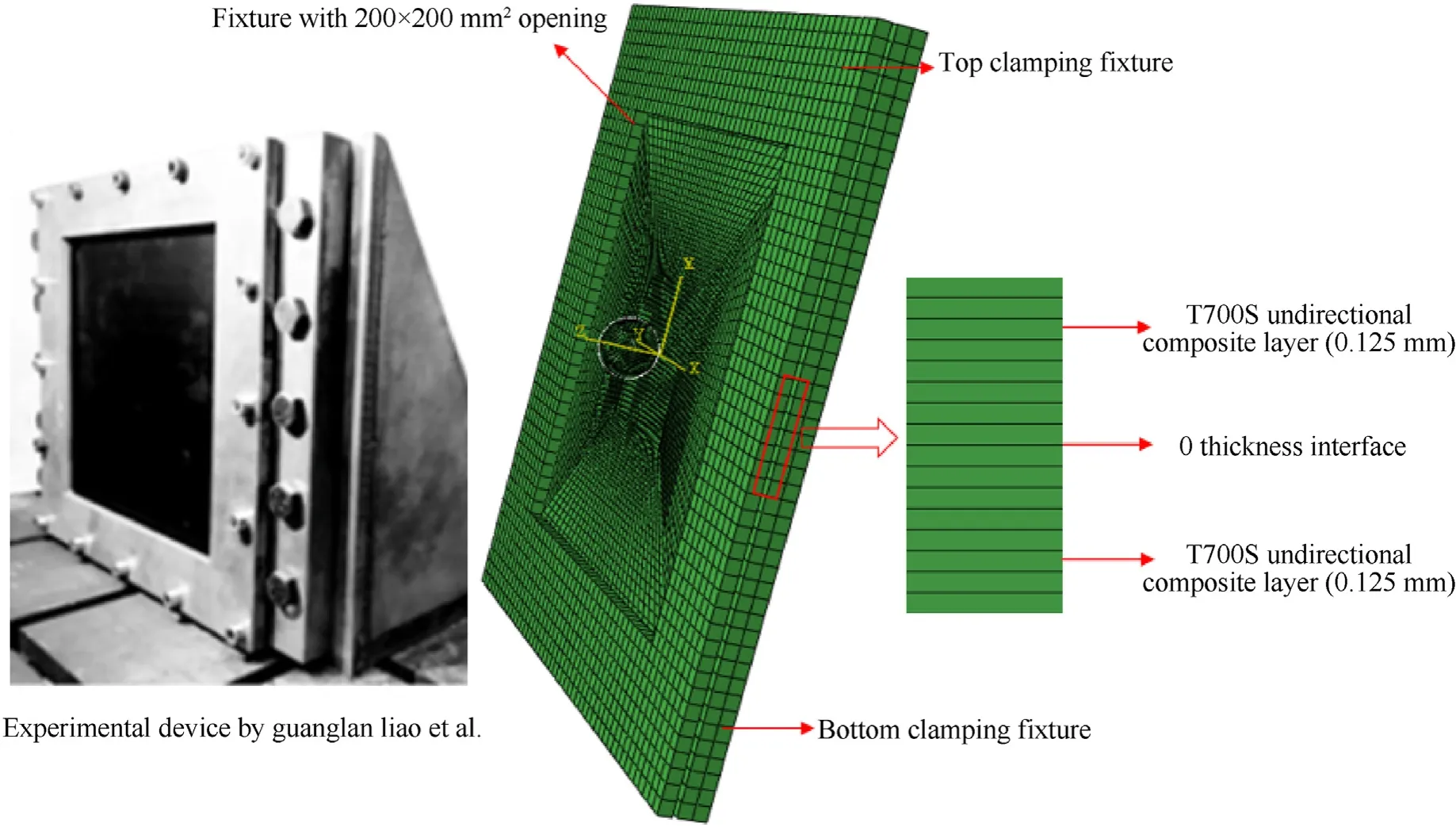
Fig.1.Experimental device and FE model of composite laminates under high velocity impact of hail ice.
During the impact process,the damage of composite laminates is mainly concentrated in the central region.Therefore,the mesh is refined in the central region and the size is 1.74 × 1.74 mm2“General contact”between the hail and laminates is defined,and the contact properties are set as “hard”with a small coefficient of friction.“Tie”constraints are established between the laminates and fixtures.The fixtures are discrete rigid bodies and the clamping conditions in the experiment are simulated by fixing the reference point.The material parameters of unidirectional composite and cohesive interfacial element are summarized in Tables 5 and 6.
Fig.2 displays the comparison between experimental and numerical macroscopic damage in two laminates under hail impact at 206 m/s.It can be found that there is a small amount of fiber breaking and matrix cracking on the front of orthogonal laminates,and a circular bulge (D=100 mm,H=6 mm) on the back.Meanwhile,the quasi-isotropic laminates has no significant fiber or matrix damage on the front while a circular bulge (D=94 mm,H=6 mm)on the back.Fig.3 illustrates the comparison of C-scan and numerical inter-laminar delamination in two laminates under hail impact at 206 m/s.In the C-scan image,when the color is closer to blue,the thickness of the non-destructive testing is thinner which also means the more serious of delamination phenomenon.The right part shows the overlay of the projected contours of delamination area of each interface in simulation.The numerical results of inter-laminar damage are in good agreement with the experimental results in terms of delamination shape.The matching characteristics of macroscopic damage and inter-laminar delamination of composite laminates between numerical and experimental results verifies the effectiveness of the proposed damage models and modeling strategy.
3.2.FE model for sandwich structure under hail impact
The FE model for hybrid corrugated sandwich structures under hail impact is described in Fig.4.The sandwich structure consists of composite sheets,corrugated aluminum core and adhesive layers between sheets and core.The sandwich structure is fully fixed on all sides,and the specimen is also fastened to the bottom plate through the pressure plate and bolts.The fixture is a 4 mm thick steel square frame with 80×80 mm2square opening.The meshing technique,elements type,boundary conditions and contact definition are all the same as that in Section 3.1.
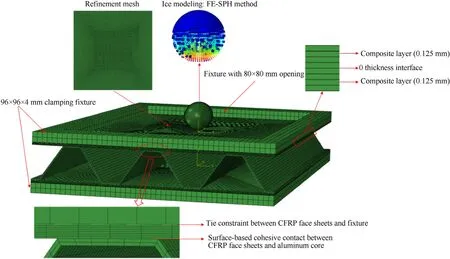
Fig.4.FE model of corrugated sandwich structure under hail impact.
The geometric configurations of two kinds of core structure cited from Ref.[2]are represented in Fig.5.The composite sheets of orthogonal layup [0°/90°]2Sare with 96 × 96 mm2square side dimensions.The corrugated core is made from aluminum alloy 2024-T3 and its material properties are listed in Table 7.In order to simulate the debonding behavior of adhesive layers,the interface between sheets and core are defined by surface-based cohesive contact.The parameters of composite-aluminum contact interface are summarized in Table 8.

Fig.5.Geometric configurations of two kinds of corrugated core.
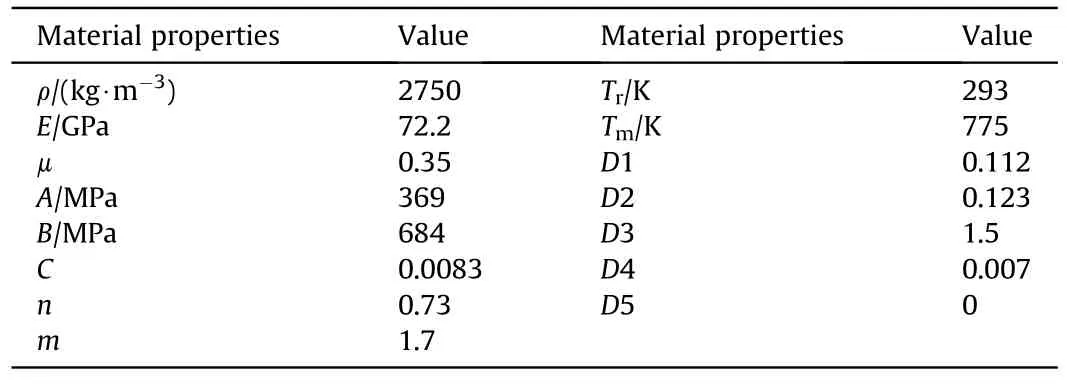
Table 7 Material properties of Aluminum 2024-T3 [29].

Table 8 Parameters of composite-aluminum core interface [30].
4.Numerical results and discussion
In the present work,the dynamic process of hybrid corrugated core sandwich structure under high velocity hail ice impact is simulated using ABAQUS/Explicit module.The specimens with two kinds of aluminum core (trapezoidal and rectangular shape) are impacted under different velocities (i.e.,100,200 and 300 m/s).Two diameters of hail (12 and 20 mm) and two impact locations(node impact and base impact) are involved.In these cases,the different damage states of corrugated sandwich structures under high velocity hail ice impact,from minor to severe,can be well considered.Node impact refers to the bonding area between top platform of sheet and core,while base impact refers to the unsupported long span center of sheet,as demonstrated in Fig.6.

Fig.6.Different impact location: (a) Node impact;(b) Base impact.
4.1.Simulation of hail ice impact process
Through FE simulation,the dynamic response of hail and deformation of corrugated core sandwich structure in the impact process can be replicated in detail.Fig.7 illustrates the impact process of trapezoidal core sandwich structure under 20 mm hail ice at 200 m/s.The numerical FE simulation basically reproduces the plastic deformation and flow characteristics of hail.In the early stage of impact,only the hail elements near the contact area fail and are converted into SPH particles,as shown in Fig.7(a).And then,significant elasto-plastic deformation appears and most of the hail elements have been converted into SPH particles.At this time,the top sheet and aluminum core have undergone significant deformation,as shown in Fig.7(b).As the impact continues,the hail elements begin to discretely impact on the sandwich structure in the form of particles,as displayed in Fig.7(c).Att=0.2 ms,as shown in Fig.7(d),the particles behave like fluid and the contact area between hail and sandwich structure increases gradually.The deformation of top sheet is more apparent while the plastic damage of core is not obvious.In addition,it can be observed that the interface debonding appears between the bottom sheet and core.Then,the particles start to rebound upward and the deformation of top sheet gradually recovers,as shown in Fig.7(e).Thereafter,the SPH particles rebound upward and the deformation of top sheet recovers to a lower level.The debonding phenomenon also appears between top sheet and core and that between bottom sheet and core also develops,as displayed in Fig.7(f).Due to the coupling effect of fiber breaking,matrix cracking,delamination and plastic buckling,a large circular pit is left on the top sheet and irrecoverable plastic buckling deformation happens in the aluminum core.
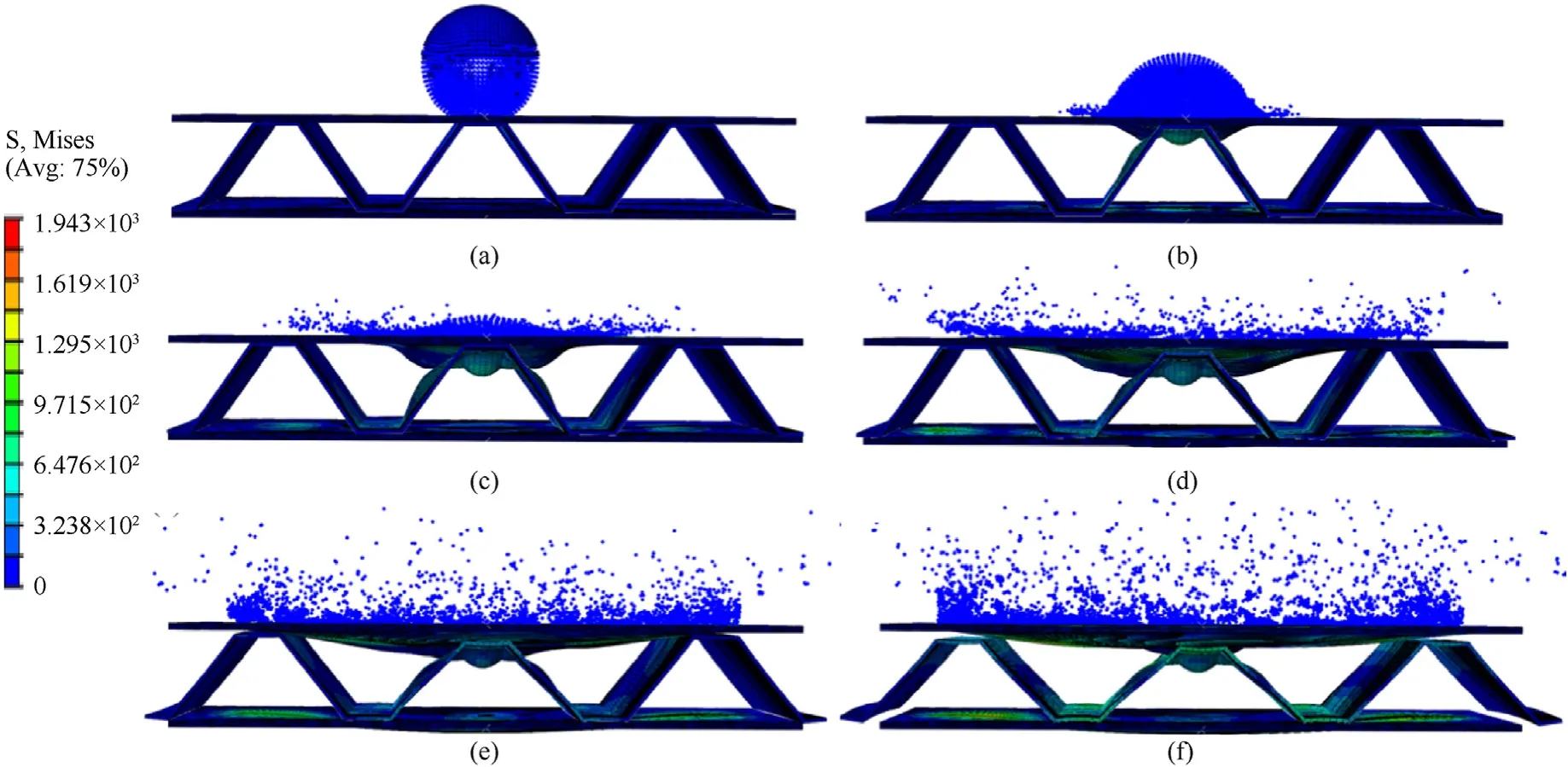
Fig.7.Impact process of trapezoidal core sandwich structure under 20 mm hail node impact at 200 m/s:(a)t=0.01 ms;(b)t=0.05 ms;(c)t=0.1 ms;(d)t=0.2 ms;(e)t=0.3 ms;(f) t=0.4 ms.
4.2.Damage characteristics for node impact
4.2.1.Trapezoidal corrugated core sandwich structure
For 12 mm spherical hail ice,under the impact velocity of 100 m/s,the damage of sandwich structure is not obvious.Only very slight matrix cracking appears at the center of top sheet.As the impact velocity increases to 200 m/s,the damage modes of sandwich structure are mainly matrix cracking and interface delamination but the damage is still not obvious.At 300 m/s,there is a larger damaged area of matrix cracking and delamination and slight fiber breaking occurs in the 8th composite ply,as displayed in Fig.8.The red region indicates matrix cracking and the white region indicates both fiber and matrix have been damaged and the elements have been deleted from the FE model.For the cohesive interfacial elements,if the damage variable reaches 0.99,it is considered that the complete delamination has occurred and the failed elements are removed.Besides,it can be also observed that slight debonding phenomenon appears between the bottom sheet and core.

Fig.8.Damage behavior of trapezoidal core sandwich structure under 12 mm hail node impact at 300 m/s.
For 20 mm spherical hail ice,under the impact velocity of 100 m/s,only a small amount matrix cracking and interface delamination appear.When the impact velocity increases to 200 m/s,the sandwich structure fails seriously.Fiber breaking and matrix cracking occur in each ply of the top sheet accompanied by delamination phenomenon.Plastic buckling deformation also takes place in the trapezoidal aluminum core.At 300 m/s,the whole sandwich structure suffers particularly severe impact damage as exhibited in Fig.9.The top sheet has been completely penetrated and some hail particles have directly interacted with the aluminum core.Each ply of the top sheet has a large region of fiber breaking and matrix cracking and the damaged shape is close to rectangular.Slight matrix cracking occurs around each ply of bottom sheet and it may be caused by the extrusion of aluminum core and bottom sheet.Severe delamination phenomenon also occurs in the top sheet correspondingly and the shape is also rectangular.With increasing the impact energy,the debonding distance between bottom sheet and core mainly develops along the in-plane tangential direction while that between top sheet and core is basically unchanged.In addition,the aluminum core suffers a large area of plastic buckling damage.
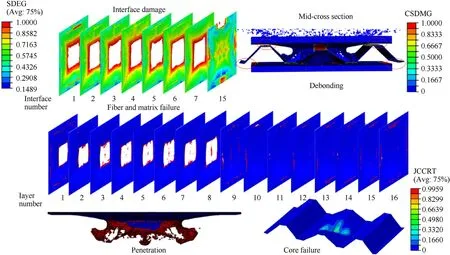
Fig.9.Damage behavior of trapezoidal core sandwich structure under 20 mm hail node impact at 300 m/s.
4.2.2.Rectangular corrugated core sandwich structure
For 12 mm spherical hail ice,under the impact velocity of 100 m/s,no visible damage is observed in the sandwich structure.As the impact velocity increases to 200 m/s,the damage behavior of rectangular core sandwich structure in this case is shown in Fig.10.Matrix damage occurs in the central region of each ply of top sheet and slight fiber breaking happens in the 1st ply.The delamination damage on other interfaces is relatively slight except on interface 5.Debonding phenomenon between the sheets and aluminum core is not observed which is different from that in trapezoidal core case.At 300 m/s,the top sheet suffers more serious damage in the form of fiber breaking,matrix cracking and delamination.However,no obvious matrix damage happens in the bottom sheet which is different for trapezoidal core in the same impact condition.
For 20 mm spherical hail ice,under the impact velocity of 100 m/s,the matrix cracking and delamination occur on the top sheet while the fiber breaking is very slight.As the impact velocity increases to 200 m/s,the damage behavior of rectangular core sandwich structure in this case is shown in Fig.11.The central region of top sheet suffers more serious damage in the form of fiber breaking,matrix cracking and delamination.A small area of penetration occurs throughout the top sheet.Slight matrix damage occurs in the outer area of the 1st ply of top sheet due to the diffusion of hail particles.The delamination area has increased significantly compared that at 100 m/s and the delamination shape is approximately oval.Besides,the plastic damage occurs in the center of the trapezoidal core but the debonding is not observed.At 300 m/s,the top sheet has a large area of penetration and the perforation shape is roughly square.Serious fiber breaking and matrix cracking occur in the top sheet accompanied with obvious square delamination.Due to the penetration of top sheet,the hail elements impact on the rectangular aluminum core and produce significant plastic deformation.Under the extrusion between bottom sheet and core,slight matrix damage also occurs on both sides of bottom sheet.Besides,the debonding phenomenon of rectangular core sandwich structure is relatively slight compared with that of trapezoidal sandwich structure.It can be concluded that the rectangular sandwich structure shows better stiffness properties and impact resistance under high velocity soft impact events.
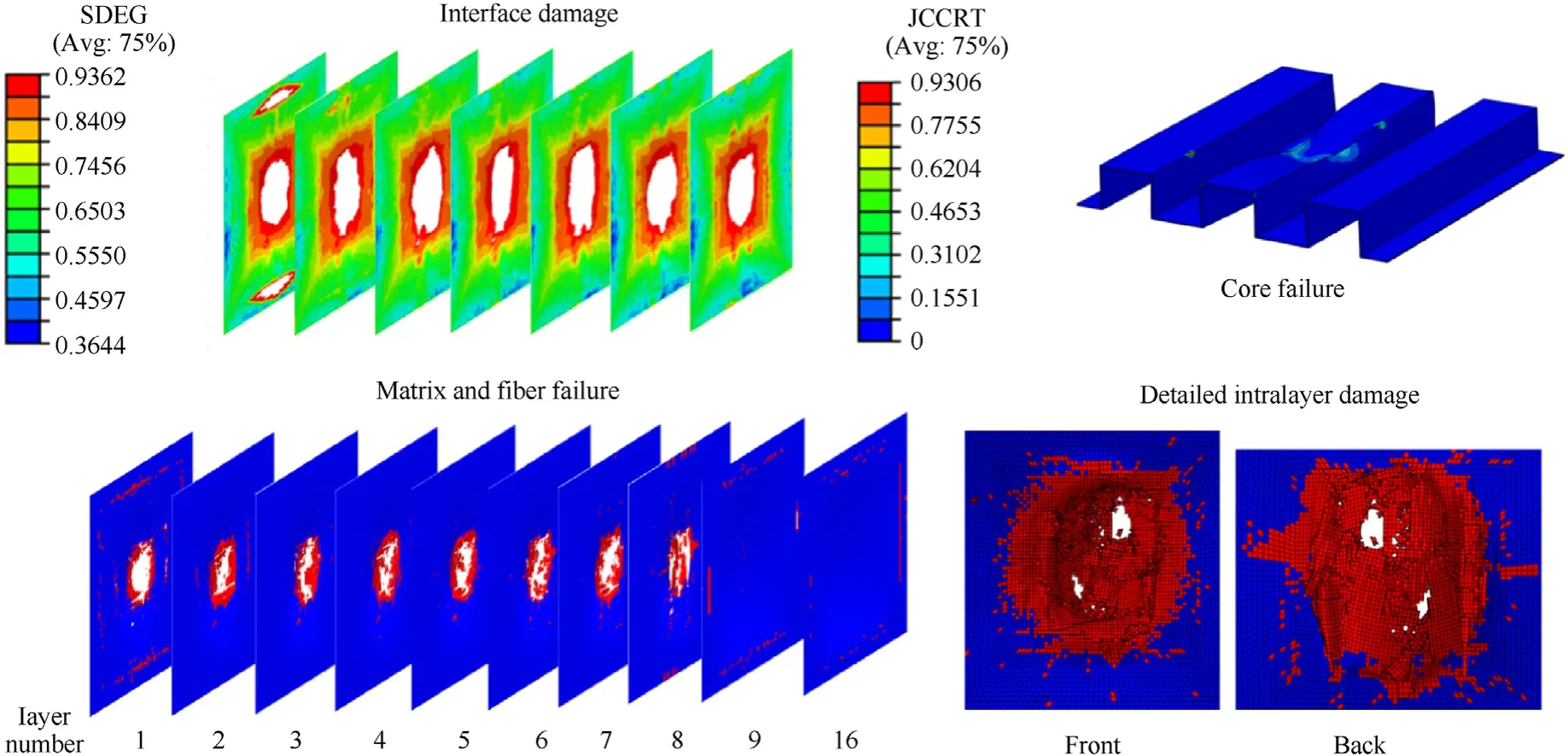
Fig.11.Damage behavior of rectangular core sandwich structure under 20 mm hail node impact at 200 m/s.
4.3.Damage characteristics for base impact
4.3.1.Trapezoidal corrugated core sandwich structure
For 12 mm spherical hail ice,under the impact velocity of 100 m/s,the damage is mainly matrix cracking of top sheet and the damage area is larger than that in node impact situation.As the impact velocity increases to 200 m/s,the damage behavior of trapezoidal core sandwich structure in this case is shown in Fig.12.Similarly,the matrix damage area increases significantly compared with node impact case.Slight fiber breaking appears in the 7th and 8th plies and the delamination becomes more serious.This may be because under base impact,the trapezoidal core sandwich structure loses the support of aluminum core.At 300 m/s,the central area of the top sheet is completely penetrated,which is very different from the node impact results.The primary damage morphology is the large area of fiber breaking,matrix cracking and delamination while there is no obvious plastic deformation in the trapezoidal aluminum core.In addition,the shape of the penetration is roughly rectangular and no debonding phenomenon is observed.
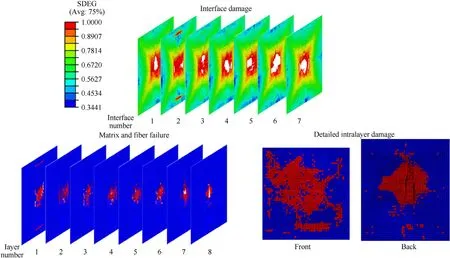
Fig.12.Damage behavior of trapezoidal core sandwich structure under 12 mm hail base impact at 200 m/s.
For 20 mm spherical hail ice,under the impact velocity of 100 m/s,the damage state is similar to that of 12 mm hail at 200 m/s.As the impact velocity increase to 200 m/s,the penetration occurs on the top sheet and the damage modes are fiber breaking,matrix cracking and delamination.However,no obvious damage happens on the bottom sheet.The plastic deformation of trapezoidal aluminum core is relatively slight and the debonding distance is not evident compared with that in node impact situation,as shown in Fig.13.At 300 m/s,the central area of top sheet has been completely penetrated and some hail particles continue to impact the core and bottom sheet at a high velocity.Extensive fiber breaking and matrix cracking occurs on the top sheet accompanied with delamination damage.Significant matrix cracking and delamination also happens in the bottom sheet with slight fiber breaking that is not observed in the node impact situation.In addition,the aluminum core is also suffered plastic buckling and the debonding distance is shorter than that for node impact.

Fig.13.Damage behavior of trapezoidal core sandwich structure under 20 mm hail base impact at 200 m/s.
4.3.2.Rectangular corrugated core sandwich structure
For 12 mm spherical hail ice,under the impact velocity of 100 m/s,the damage area of matrix cracking is slightly larger than that for node impact because there is no supporting effect of aluminum core.As the impact velocity increases to 200 m/s,the damage modes are mainly matrix cracking and delamination and fiber breaking only happens in the 8th ply.At 300 m/s,the damage modes of matrix cracking and delamination continually develops and additional fiber breaking occurs,as depicted in Fig.14.The central area of top sheet is completely penetrated and the detailed intra-laminar damage form is provided here.
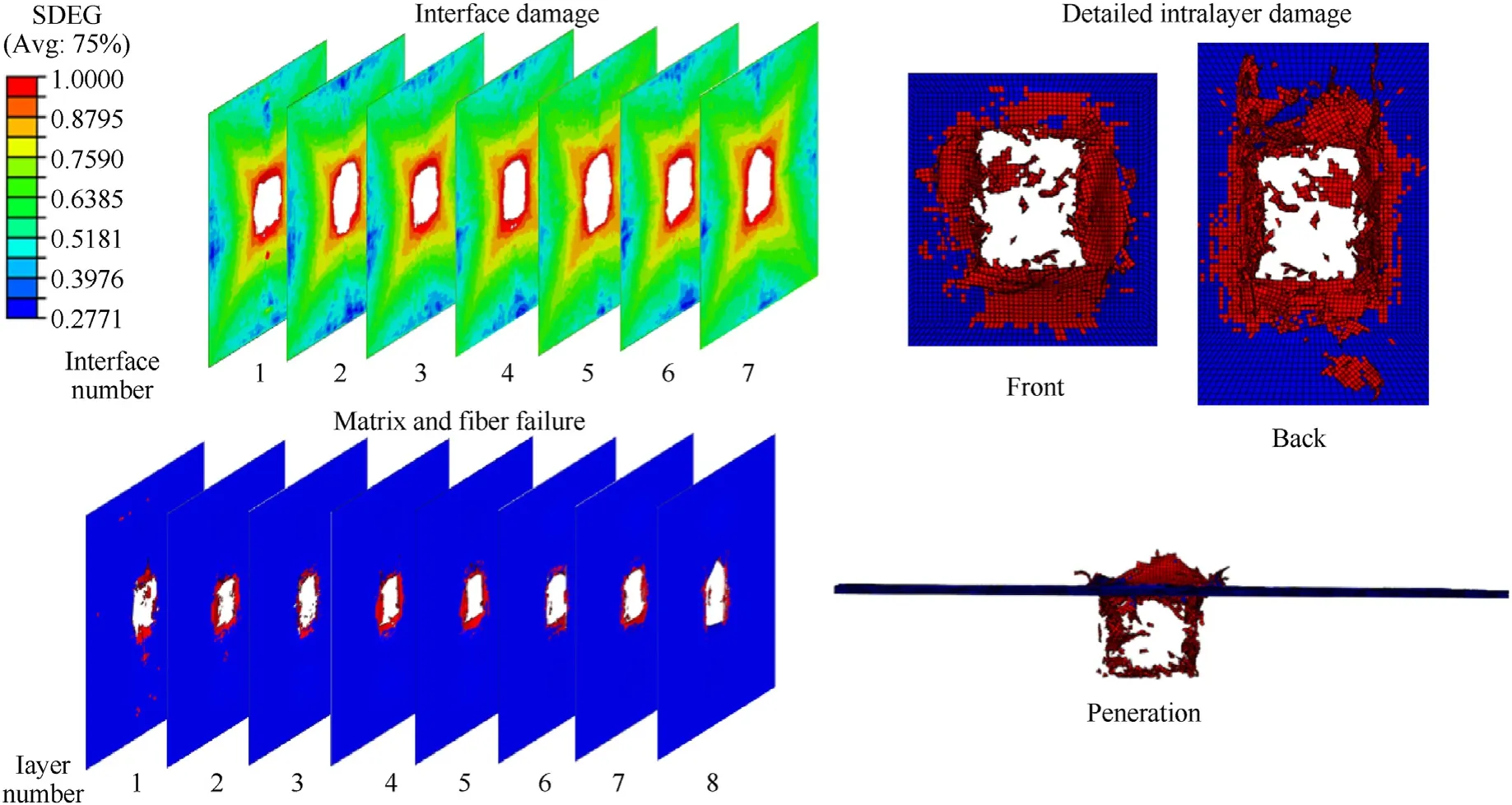
Fig.14.Damage behavior of rectangular core sandwich structure under 12 mm hail base impact at 300 m/s.
For 20 mm spherical hail ice,under the impact velocity of 100 m/s,the damage state is also similar to that of 12 mm hail at 200 m/s.As the impact velocity increase to 200 m/s,a rectangular perforation is left on top sheet after impact.Significant fiber breaking,matrix cracking and delamination also occur on the top sheet while the bottom sheet has slight matrix cracking caused by the extrusion between bottom sheet and aluminum core.At 300 m/s,the top sheet is completely penetrated with severe fiber breaking,matrix cracking and delamination phenomenon,as depicted in Fig.15.Significant matrix cracking happens in the bottom sheet accompanied by fiber breaking in the 16th ply.The damage of bottom face sheet is more serious than that for node impact situation but no debonding phenomenon is observed in the current impact condition.Besides,the plastic deformation of the rectangular core is significantly slighter than that for node impact situation.
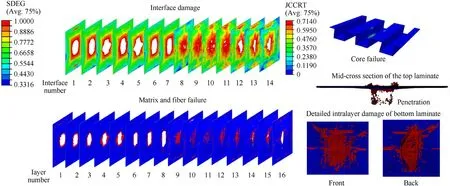
Fig.15.Damage behavior of rectangular core sandwich structure under 20 mm hail base impact at 300 m/s.
All the predicted damage modes of sandwich structures under different impact conditions are summarized in Table 9.From Table 9,it can be concluded that matrix cracking in the top sheet is the main initial damage mode.As the impact energy increases,delamination and fiber breaking begin to occur in the top sheet.When the impact energy is high enough,the sandwich structure suffers catastrophic damage,such as plastic deformation of the core,debonding between the sheet and core and severe penetration.Besides,the damage of corrugated sandwich structure is very sensitive to the diameter of hail ice.For the impact events of largediameter hail,the damage morphology is more serious with penetration and debonding phenomenon,which greatly reduces the stability and residual bearing capacity of the structure.Trapezoidal sandwich structure is more prone to debonding than rectangular structure,and the plastic buckling is also greater than that of rectangular structure under the same impact conditions.In addition,the damage of base impact is mainly concentrated in the top sheet and this impact position is more likely to cause penetration.
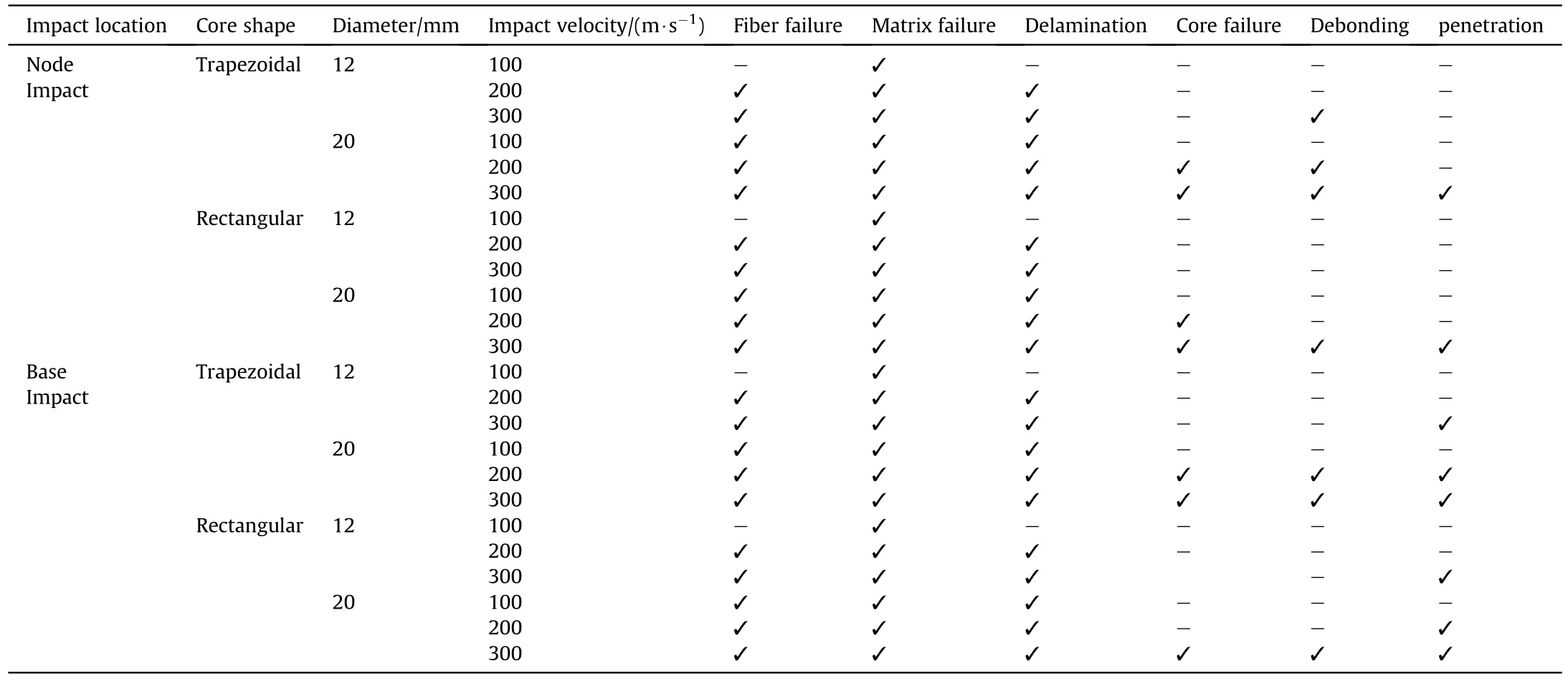
Table 9 Predicted damage modes of sandwich structure under different impact conditions.
4.4.Dynamic response analysis
The influence of core structure and impact position on the dynamic response of corrugated sandwich structure is analyzed.The impact force-time curves and displacement-time curves for different impact case are investigated.
The impact force is one of the key factors to quantify the structural dynamic response.Figs.16 and 17 illustrate the comparison of impact force-time curves for different impact conditions.The maximum impact force occurs shortly after the hail interacts on the sandwich structure.In the later stage of impact,the impact force is nearly zero and the hail commonly sputters on the sandwich structure as SPH particles.Generally,with increasing the impact velocity,the maximum impact force also increases accordingly.The shape of core and the impact position have no obvious effects on the maximum impact force and it mainly generated in the early stage of impact when the stress wave has not yet propagated to the core and bottom sheet.It can also be found that under lower impact energy,the impact force decreases gently after reaching the peak force while it decreases sharply after reaching the peak under higher impact energy.Particularly,it can be found that in Fig.16(c) the impact force falls sharply after reaching the peak and then rises sharply.It can be attributed to the hail rupture and flow characteristics and the coupling of various damage modes in the corrugated sandwich structure under this specific impact condition.
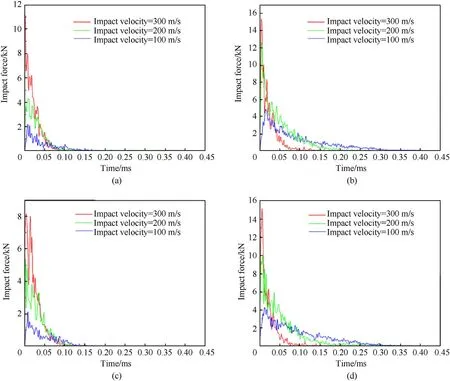
Fig.16.Comparison of impact force-time curves for node impact cases: (a) Trapezoidal core,12 mm hail;(b) Trapezoidal core,20 mm hail;(c) Rectangular core,12 mm hail;(d)Rectangular core,20 mm hail.
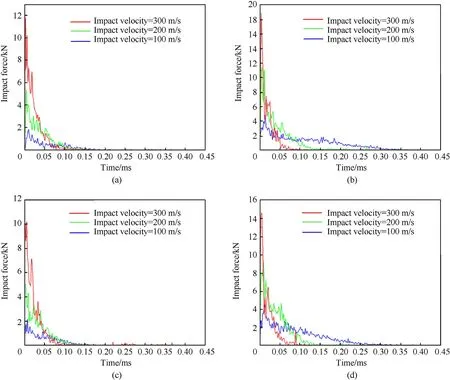
Fig.17.Comparison of impact force-time curves for base impact cases: (a) Trapezoidal core,12 mm hail;(b) Trapezoidal core,20 mm hail;(c) Rectangular core,12 mm hail;(d)Rectangular core,20 mm hail.
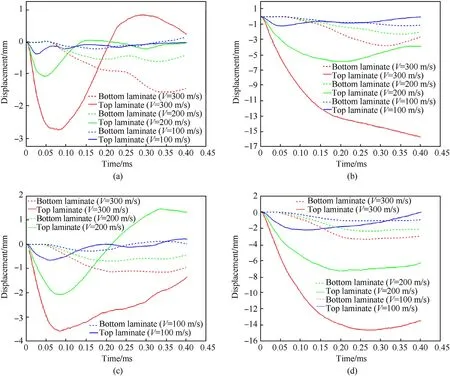
Fig.18.Comparison of displacement-time curves for node impact cases: (a) Trapezoidal core,12 mm hail;(b) Trapezoidal core,20 mm hail;(c) Rectangular core,12 mm hail;(d)Rectangular core,20 mm hail.
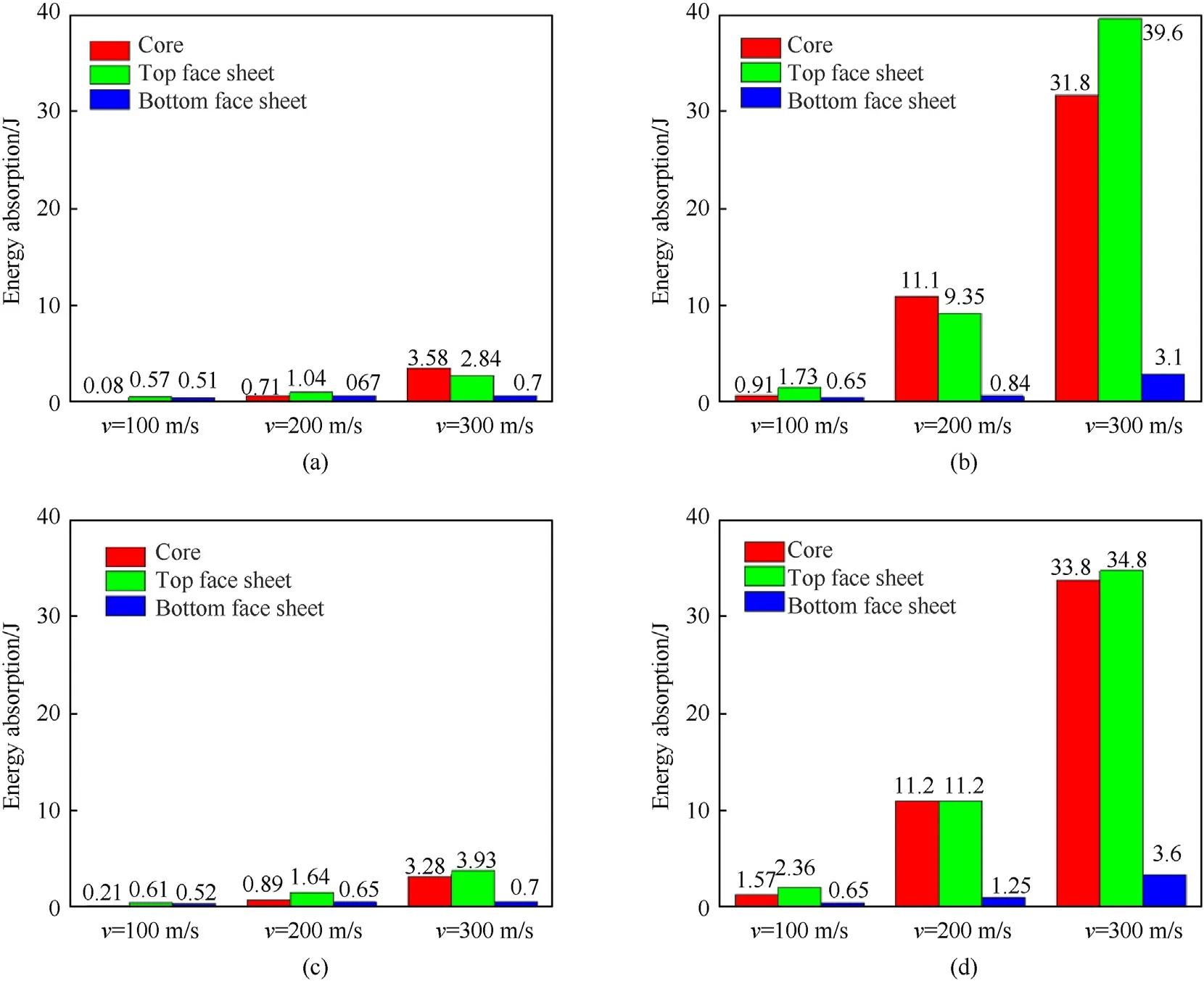
Fig.20.Comparison of energy absorption of corrugated core sandwich structures for node impact cases: (a) Trapezoidal core,12 mm hail;(b) Trapezoidal core,20 mm hail;(c)Rectangular core,12 mm hail;(d) Rectangular core,20 mm hail.

Fig.21.Comparison of energy absorption of corrugated core sandwich structures for base impact cases: (a) Trapezoidal core,12 mm hail;(b) Trapezoidal core,20 mm hail;(c)Rectangular core,12 mm hail;(d) Rectangular core,20 mm hail.
Figs.18 and 19 demonstrate the displacement-time curves of center points of sheets for different impact conditions.It is shown that under the hail ice impact,the deformation of bottom sheet of sandwich structure is always not obvious.The bottom sheet maintains small vibration in the whole impact process,which is consistent with the damage status.Therefore,the bottom plate can maintain the structural stability of sandwich structure during the hail ice impact process.Overall,the maximum displacement of top sheet in node impact is much less than that in base impact for 12 mm hail condition while this is not obvious for 20 mm hail condition.For 20 mm hail impact case at 300 m/s,a large and unrecoverable displacement occurs in the center of top sheet because of penetration.For the low energy impact,the center point of top sheet quickly bends and deforms to the maximum displacement in the early stage of impact,and then the top sheet gradually rebounds and even increases in the reverse displacement in the late stage of impact.However,for the base impact,the variation of displacement at the center of the top panel is much greater than that under node impact.A permanent penetration occurs on the top sheet subjected to hail impact at 300 m/s.Therefore,the impact position has a great influence on the displacement response of top sheet.In addition,for node impact case,the maximum displacement of rectangular sandwich structure is slightly larger than that of trapezoidal sandwich structure.
4.5.Energy absorption characteristics
To quantitatively investigate the energy absorption of corrugated composite sandwich structure,the energy absorptions of each part of sandwich structure are provided in Figs.20 and 21.The energy absorption value of each part of the sandwich structure is obtained according to the variation of the kinetic energy and internal energy of panel and core elements extracted in the impact simulation process.It should be pointed out that the mass of the two core configurations is not equal here.It can be observed that the top sheet and aluminum core are the main energy absorption parts in node impact events while that is only top sheet in base impact cases.Besides,the bottom sheet makes little contribution for energy absorption since only slight matrix cracking happens in the bottom sheet.Under higher impact energy,most impact energy is absorbed by fiber breaking,matrix cracking,delamination and plastic deformation of aluminum core.Part of impact energy is absorbed by debonding response in the adhesive layer between sheets and core.It can also be seen that for node impact case,the energy absorptions of trapezoidal and rectangular cores are almost the same.However,for base impact,the rectangular core exhibits the superiority of energy absorption capacity than trapezoidal core subjected to higher impact energy.With increasing of impact energy,the energy absorbed by sandwich structure also increases significantly.By comparison,it can be concluded that under higher impact energy,the node impact case tends to absorb more energy in total than that for base impact.It can be attributed to that the plastic damage of core in the base impact is smaller than that for node impact.
5.Conclusions
In this paper,we have presented a nonlinear FE model to explore the dynamic response,damage behavior and energy absorption characteristics of corrugated sandwich structures under hail ice impact.Several major conclusions drawn from the study can be summarized as follows:
(1) The developed FE model accurately replicates the hail ice impact behavior and reproduces the impact process of sandwich structure.The macroscopic damage and interlaminar delamination of composite laminates are in good agreement with the reference experimental data,reflecting the effectiveness of the developed damage models and modeling strategy.
(2) The matrix cracking in the top sheet is the primary initial damage mode in sandwich structure.As the impact energy increases,the delamination and fiber breaking occurs.Particularly serious damage such as plastic deformation of core,debonding and penetration phenomenon appear in higher impact energy.The trapezoidal sandwich structure is found to be more prone to debonding than the rectangular structure.The damage of base impact case is mainly concentrated on the top sheet and this position is more likely to cause penetration.
(3) The maximum impact force generated in the early stage of impact while the debonding between sheets and aluminum core appears in the late stage of impact.As long as the top sheet is not penetrated,the bending deformation of the top panel will gradually rebound until a circular pit is left while the plastic buckling of aluminum core cannot be recovered.The impact position greatly affects the displacement response of top sheet while the bottom sheet is insensitive to it.
(4) For node impact,the top sheet and aluminum core plays an important role in energy absorption while that is only top sheet for base impact.In node impact case,the energy absorption of the trapezoidal core and rectangular core are almost the same.But for the base impact case,the rectangular core exhibits the superiority of energy absorption capacity than trapezoidal core subjected to higher impact energy.The bottom sheet mainly plays a supporting role in the impact process while makes little contribution to energy absorption.
(5) The developed FE model is effective in implementing the hail ice impact simulation of corrugated sandwich structures.The present numerical results offer new insights for the hail ice impact issues of sandwich structures and also provide transferable technique for the soft body impact study of other composite structures.
Declaration of competing interest
The authors declare that they have no known competing financial interests or personal relationships that could have appeared to influence the work reported in this paper.
Acknowledgment
This work was supported by the Natural Science Foundation of Jiangsu Province (Grant No.BK20180855),Research Fund of State Key Laboratory of Mechanics and Control of Mechanical Structures(Grant No.MCMS-E-0219Y01) and Research and Practice Innovation Program of postgraduates in Jiangsu Province (Grant No.KYCX20-3076).
杂志排行
Defence Technology的其它文章
- An energetic nano-fiber composite based on polystyrene and 1,3,5-trinitro-1,3,5-triazinane fabricated via electrospinning technique
- Dynamic response of UHMWPE plates under combined shock and fragment loading
- Aerial multi-spectral AI-based detection system for unexploded ordnance
- Model-based deep learning for fiber bundle infrared image restoration
- Robust design and analysis for opto-mechanical two array laser warning system
- Combustion behavior and mechanism of molecular perovskite energetic material DAP-4-based composites with metal fuel Al
